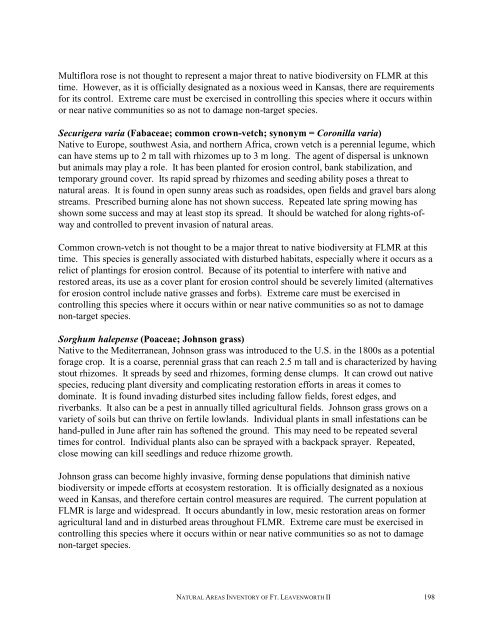A Natural Areas Inventory of the - Kansas Natural Heritage Inventory ...
A Natural Areas Inventory of the - Kansas Natural Heritage Inventory ...
A Natural Areas Inventory of the - Kansas Natural Heritage Inventory ...
You also want an ePaper? Increase the reach of your titles
YUMPU automatically turns print PDFs into web optimized ePapers that Google loves.
Multiflora rose is not thought to represent a major threat to native biodiversity on FLMR at this<br />
time. However, as it is <strong>of</strong>ficially designated as a noxious weed in <strong>Kansas</strong>, <strong>the</strong>re are requirements<br />
for its control. Extreme care must be exercised in controlling this species where it occurs within<br />
or near native communities so as not to damage non-target species.<br />
Securigera varia (Fabaceae; common crown-vetch; synonym = Coronilla varia)<br />
Native to Europe, southwest Asia, and nor<strong>the</strong>rn Africa, crown vetch is a perennial legume, which<br />
can have stems up to 2 m tall with rhizomes up to 3 m long. The agent <strong>of</strong> dispersal is unknown<br />
but animals may play a role. It has been planted for erosion control, bank stabilization, and<br />
temporary ground cover. Its rapid spread by rhizomes and seeding ability poses a threat to<br />
natural areas. It is found in open sunny areas such as roadsides, open fields and gravel bars along<br />
streams. Prescribed burning alone has not shown success. Repeated late spring mowing has<br />
shown some success and may at least stop its spread. It should be watched for along rights-<strong>of</strong>way<br />
and controlled to prevent invasion <strong>of</strong> natural areas.<br />
Common crown-vetch is not thought to be a major threat to native biodiversity at FLMR at this<br />
time. This species is generally associated with disturbed habitats, especially where it occurs as a<br />
relict <strong>of</strong> plantings for erosion control. Because <strong>of</strong> its potential to interfere with native and<br />
restored areas, its use as a cover plant for erosion control should be severely limited (alternatives<br />
for erosion control include native grasses and forbs). Extreme care must be exercised in<br />
controlling this species where it occurs within or near native communities so as not to damage<br />
non-target species.<br />
Sorghum halepense (Poaceae; Johnson grass)<br />
Native to <strong>the</strong> Mediterranean, Johnson grass was introduced to <strong>the</strong> U.S. in <strong>the</strong> 1800s as a potential<br />
forage crop. It is a coarse, perennial grass that can reach 2.5 m tall and is characterized by having<br />
stout rhizomes. It spreads by seed and rhizomes, forming dense clumps. It can crowd out native<br />
species, reducing plant diversity and complicating restoration efforts in areas it comes to<br />
dominate. It is found invading disturbed sites including fallow fields, forest edges, and<br />
riverbanks. It also can be a pest in annually tilled agricultural fields. Johnson grass grows on a<br />
variety <strong>of</strong> soils but can thrive on fertile lowlands. Individual plants in small infestations can be<br />
hand-pulled in June after rain has s<strong>of</strong>tened <strong>the</strong> ground. This may need to be repeated several<br />
times for control. Individual plants also can be sprayed with a backpack sprayer. Repeated,<br />
close mowing can kill seedlings and reduce rhizome growth.<br />
Johnson grass can become highly invasive, forming dense populations that diminish native<br />
biodiversity or impede efforts at ecosystem restoration. It is <strong>of</strong>ficially designated as a noxious<br />
weed in <strong>Kansas</strong>, and <strong>the</strong>refore certain control measures are required. The current population at<br />
FLMR is large and widespread. It occurs abundantly in low, mesic restoration areas on former<br />
agricultural land and in disturbed areas throughout FLMR. Extreme care must be exercised in<br />
controlling this species where it occurs within or near native communities so as not to damage<br />
non-target species.<br />
NATURAL AREAS INVENTORY OF FT. LEAVENWORTH II 198


